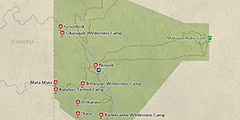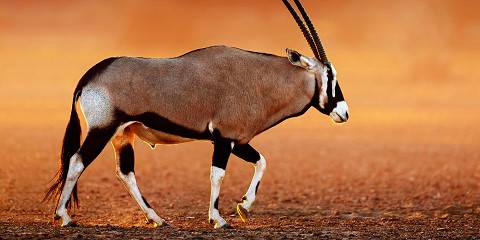Kgalagadi Transfrontier Park is a merger of Kalahari Gemsbok National Park in South Africa and Gemsbok National Park in Botswana. Most tourism happens on the South Africa side, which has excellent facilities. The Botswana side only has very basic campsites. The red sand dunes in the inhospitable desert form a magnificent backdrop for wildlife viewing and photography.

-
Best Time To Go
- March to May (The riverbeds attract animals)
-
High Season
- Never (The park never gets very crowded)
-
Size
- 35,284km² / 13,623mi²
-
Altitude
-
868-1,197m /2,848-3,927ft
 View Photos
View Photos
 View Photos
+24
Photos
View Photos
+24
Photos
 Open Map
Open Map
Pros & Cons
- Excellent wildlife viewing
- Stunning desert scenery and great photographic opportunities
- Great birding, especially raptors
- Off-the-beaten-track destination with great wilderness appeal
- Upmarket lodge and self-catering accommodation (South Africa)
- Less variety of animals than in savannah reserves
- Far away from South Africa's main tourist attractions
- Very hot conditions
Wildlife
The Kgalagadi is not a Big Five destination, as it has no elephant, rhino or buffalo. Animal numbers are lower than in more classic safari destinations, but the open terrain makes for very good viewing. Predators are the park’s biggest attraction. These include leopard, cheetah, spotted and brown hyena and smaller species such as bat-eared fox and Cape fox. Lions are numerous and males are known for their spectacular black manes.
More about Kgalagadi’s wildlifeScenery
For many people, the scenery is as much an attraction of this park as the wildlife. The red sand dunes and endless vistas are quite unique. The dry riverbeds of the Nossob and Auob are lifelines in this harsh environment.
Weather & Climate
Forceful storms dump a large amount of water on the Kgalagadi during the park’s summer (October to April). This is when it can also get fiercely hot here, though thankfully the humidity doesn’t hit similar heights. You’ll often wake up to subzero temperatures during winter (May to September), which transform into crisp, sunny days.
More about the weather and climateBest Time To Visit
The period of transition from the Wet season (October to April) to the Dry season (May to September) is the best time for wildlife viewing. The worst of the heat will have passed, and there’ll be enough water in the rivers to draw lots of animals. Just remember to pack plenty of warm clothes to deal with plummeting temperatures in the evening, as well as the chilly morning air.
More about the best time to visit



